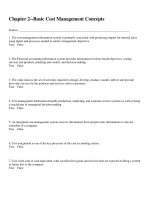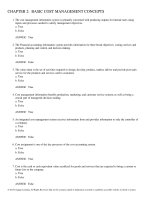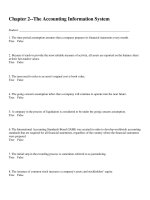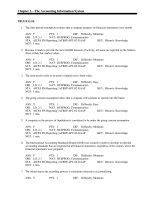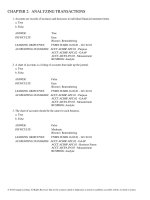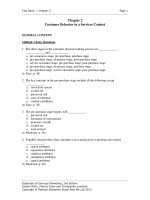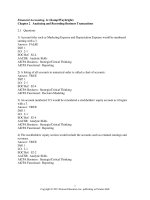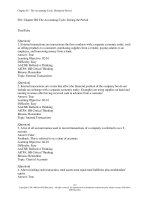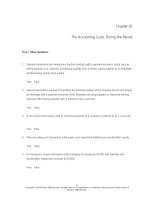Cornerstones of financial accounting 2nd edition rich test bank
Bạn đang xem bản rút gọn của tài liệu. Xem và tải ngay bản đầy đủ của tài liệu tại đây (669.25 KB, 111 trang )
Chapter 2--The Accounting Information System
Student: ___________________________________________________________________________
1. The time-period assumption assumes that a company prepares its financial statements every month.
True False
2. Because it tends to provide the most reliable measure of activity, all assets are reported on the balance sheet
at their fair market values.
True False
3. The term used to refer to an asset's original cost is book value.
True False
4. The going concern assumption infers that a company will continue to operate into the near future.
True False
5. A company in the process of liquidation is considered to be under the going concern assumption.
True False
6. The International Accounting Standards Board (IASB) was created in order to develop worldwide accounting
standards that are required for all financial statements, regardless of the country where the financial statements
were prepared.
True False
7. The initial step in the recording process is sometimes referred to as journalizing.
True False
8. The issuance of common stock increases a company's assets and stockholders’ equity.
True False
9. The payment of a dividend increases both cash and stockholders' equity of the distributing entity.
True False
10. According to the historical cost principle, assets are always carried at their current market value.
True False
11. An accounting transaction may impact only one financial statement or multiple statements.
True False
12. The accounting equation must balance before and after every accounting transaction.
True False
13. A chart of accounts is prepared to determine whether the books have gotten out of balance.
True False
14. GAAP has established a universal chart of accounts that is applicable to all businesses in the United States.
True False
15. A T-account for Cash cannot contain any credits.
True False
16. A debit entry increases assets and revenue accounts.
True False
17. The dividends account has a normal debit balance.
True False
18. Under the double-entry system of accounting, every transaction is entered in at least two accounts on
opposite sides of a T-account.
True False
19. Under the double-entry system of accounting, a debit is always a negative entry.
True False
20. Income statement accounts have normal credit balances.
True False
21. Only events that can be measured with sufficient reliability will be recognized in the accounting system.
True False
22. The general ledger is an example of a book of original entry.
True False
23. The general ledger is often used for the initial recording of repetitive transactions.
True False
24. A trial balance is the listing of each active account and its corresponding debit or credit balance at a
particular point in time.
True False
25. Even though a trial balance reveals that the debits equal the credits, there still may be errors in the
company’s books.
True False
26. The purchase of office supplies from a supplier is an example of an external event.
True False
27. The conservatism principle is concerned with the possibility of understating assets or income.
True False
28. A full disclosure policy stipulates that all information that would make a difference to financial statement
users should be revealed.
True False
29. If a company performed services for credit, then the debit side of the journal entry would be to Accounts
Payable and the credit would be to Service Revenue.
True False
30. If a company made a payment on account, then assets and liabilities would both decrease.
True False
31. The various rules and conventions that have evolved over time to guide the preparation of financial
statements in the U.S. are called ____________________.
________________________________________
32. The concept that assumes that assets are recorded at the amount to acquire them is called the
____________________ principle.
________________________________________
33. The concept that assumes that an entity is not in the process of bankruptcy is called the ___________
concept.
________________________________________
34. The ____________________ is the U.S. federal government agency with the ultimate authority to
determine the accounting rules for companies whose stock is sold to the public.
________________________________________
35. The ____________________ is the private sector group with authority to set accounting standards in the
United States.
________________________________________
36. ____________________ is the magnitude of an omission or misstatement in accounting information that
will influence the decision of someone relying on the information.
________________________________________
37. ____________________ is the capacity of information to make a difference in a decision by helping make
timely predictions or provide timely feedback.
________________________________________
38. When preparing the financial statements, the accountant must estimate the balances of certain accounts.
When two possible estimates are available and when these estimates are about equally likely, the accountant's
prudent reaction is to select the least optimistic estimate in terms of the recorded amounts of assets or income
statement accounts. This is referred to as the principle of ____________________.
________________________________________
39. ____________________ is the quality of accounting information that makes it dependable in representing
the events that it purports to represent.
________________________________________
40. ____________________ is the quality of accounting information that allows a user to analyze two or more
companies and look for similarities and differences.
________________________________________
41. ____________________ is the quality of accounting information that allows a user to compare two or more
accounting periods for a single company.
________________________________________
42. In order for an internal or external event to be recognized in an accounting system, the items making up the
event must impact the financial statements and they must be sufficiently reliable and ____________________.
________________________________________
43. ____________________ documents provide the evidence needed in an accounting system to record a
transaction.
________________________________________
44. The issuance of common stock increases both ____________________ and stockholders' equity.
________________________________________
45. Borrowing from the bank in order to acquire computer equipment for $1,500 has the effect of increasing
both assets and ____________________.
________________________________________
46. If a law firm provides services on account for its clients, both ____________________ and retained
earnings will increase.
________________________________________
47. The payment of salaries to employees will result in a debit to an expense account and a credit to the
___________ account.
________________________________________
48. The ____________________ principle says that assets of a company are initially recorded at their original
cost.
________________________________________
49. The ____________________ is a list of all the accounts used by an entity.
________________________________________
50. The ____________________ is the file or book that contains all of the company's accounts.
________________________________________
51. The ____________________ side, or left-side, of a liability account is used to record decreases in the
account balance.
________________________________________
52. For assets, expenses, and dividend accounts, a credit will _______ the balance in the account.
________________________________________
53. For liabilities, stockholders' equity, and revenue accounts, debits will _____________ the account balance.
________________________________________
54. Credits are always on the ____________________ side of a T-account.
________________________________________
55. A revenue account has a normal ___________ balance.
________________________________________
56. The ___________________ is a chronological record of all transactions entered into by a business.
________________________________________
57. The ___________________ is a list of each active account and its debit or credit balance at a specific point
in time.
________________________________________
58. Match the following principles with their correct definition.
1. This principle is used to determine when revenue is
recorded and reported.
2. This assumption states that in the absence of
information to the contrary, it should be assumed that
a company will continue to operate indefinitely.
3. Any information that would make a difference to
financial statement users should be reported.
Historical cost ____
Conservatism ____
Going concern ____
4. The system used by companies to record the effects
of transactions on the accounting equation.
5. This principle states that accountants should take
care to avoid overstating assets or income when they
prepare financial statements.
6. This principle requires that the activities of a
company be initially measured at their exchange price
at the time the activity occurs.
7. This principle requires that an expense be recorded
and reported in the same period as the revenue it
helped generate.
Comparability ____
Time period ____
Double-entry
accounting ____
Monetary unit ____
8. This assumption states that each company will be
accounted for separately from its owners.
9. This principle divides the life of a company into
artificial time periods such as quarters and years.
10. This principle states that users should be able to
make meaningful comparisons of different
companies.
11. This assumption requires that financial
information be reported in monetary terms.
Full disclosure ____
Revenue
recognition ____
Matching ____
Economic entity
____
59. Match the following terms with their correct definition.
1. Something that happens to the business that may or
may not require a journal entry.
2. A device used to record increases and decreases in each
of the basic elements of the financial statements.
3. A chronological record showing the debit and credit
effects of transactions on a company.
4. It does not make good business expense to spend $100
to save $75.
5. Term used to refer to the left side of an account.
6. A collection of all the individual financial statement
accounts that a company uses.
7. Term used to refer to the right side of an account.
8. A list of all the accounts maintained by the business.
9. The sequence of procedures used by companies to
transform the effects of business activities into financial
statements.
10. A list of all active accounts and each account’s debit
or credit balance.
Chart of
accounts ____
Accounting
cycle ____
Account ____
General
ledger ____
Journal ____
Trial balance ____
Debit ____
Cost vs.
benefit ____
Event ____
Credit ____
60. Which of the following statements is true regarding economic events?
A. The signing of a service contract is an example of an external event that is recorded in the accounting
records.
B. Every event which affects an entity can be identified from a source document.
C. All internal and external events must be measured with sufficient reliability.
D. External events involve exchanges between an entity and another entity outside the company.
61. Which of the following underlying assumptions for the conceptual framework is the reason the dollar is
used in the preparation of financial statements?
A. Economic Entity
B. Continuity
C. Time-Period
D. Monetary Unit
62. Which of the following is an assumption made in the preparation of the financial statements?
A. Financial statements are prepared for a specific entity that is distinct from the entity's owners.
B. The current market value is assumed to be more relevant than the original cost paid.
C. The preparation of financial statements for a specific time period assumes that the balance sheet covers a
designated period of time.
D. Financial statements are prepared assuming that inflation has a distinct effect on the monetary unit.
63. The time-period assumption is necessary because
A. inflation exists and causes confusing swings in financial statement amounts over time.
B. external users of financial statements want accurately-reported net income for a specific period of time.
C. financial statements users expect full disclosure of all economic events throughout the entire time period.
D. it is required by the federal government.
64. Which of the following statements is true concerning assets?
A. Assets are measured using a time-period approach.
B. Assets are initially recorded at market value and then adjusted for inflation.
C. Assets are initially recorded using the historical cost principle.
D. Assets are initially recorded at market value, since historical cost tends to be too arbitrary.
65. Homevestors purchased land for $400,000 in 2001. In 2013, an independent appraiser assessed the value of
the land at 900,000. At what amount should the land be recorded on the company’s 2013 financial statements?
A. At its cost of $400,000
B. At its $900,000 appraised value
C. At $500,000, the difference between the land’s cost and assessed value
D. Whichever amount the company considers to be the best indicator of the land's true value.
66. Which of the following organizations is primarily responsible for establishing GAAP in the United States?
A. Securities Exchange Commission (SEC)
B. Financial Accounting Standards Board (FASB)
C. International Accounting Standards Board (IASB)
D. Internal Revenue Service (IRS)
67. The Securities Exchange Commission (SEC) is concerned with
A. Developing a new conceptual framework in order to reduce differences in financial reports for global
companies.
B. Setting accounting rules for all companies that are incorporated in the United States.
C. Setting accounting rules for publicly-traded companies in the United States.
D. Working to reduce differences in accounting reports issued by governmental units.
68. Which organization has the power to set accounting rules for companies whose stock is publicly-traded in
the U.S. stock markets, but has delegated its power to another organization?
A. International Accounting Standards Board (IASB)
B. Financial Accounting Standards Board (FASB)
C. General Association of Accounting Practitioners (GAAP)
D. Securities Exchange Commission (SEC)
69. In order for accounting information to be useful in making informed decisions, it must be
A. Internal
B. Relevant
C. Reliable
D. Both relevant and reliable
70. Which of the following is a constraint to the qualitative characteristics of useful accounting information?
A. Conservatism
B. Materiality
C. Relevance
D. Comparability
71. The principle of conservatism is concerned with
A. the avoidance of overstating assets or income in the preparation of financial statements.
B. the minimization of costs associated with providing financial information.
C. the company's ability to carry out its existing commitments.
D. the company's procedures for recording activities at their initial exchange price.
72. The going concern assumption is concerned with
A. The company's ability to continue operations long enough to carry out its existing obligations.
B. Any information that is capable of influencing the decisions of anyone using the financial statements.
C. Measuring ongoing business activities at their exchange price at the time of the initial external transaction.
D. offsetting management's natural optimism by providing a prudent approach to uncertainty in financial
statement items.
73. Which of the following statements is false with respect to the qualitative characteristics of useful accounting
information?
A. Comparability is concerned with different companies using the same accounting methods; whereas,
consistency is concerned with a single company using the same accounting methods over time.
B. Trade-offs are often necessary in evaluating relevant versus reliable information.
C. All external and internal events must be fully disclosed in the accounting system.
D. The full disclosure policy should be followed in all situations that would made a difference to financial
statement users.
74. Which of the following is an internal event?
A. Caddie salaries are paid by a country club.
B. Dividends are distributed to a company's stockholders.
C. Potatoes used to make French fries in a fast-food restaurant are purchased.
D. Products are transferred from the assembly area to the painting station.
75. All of the following are external events except:
A. a grocery store recognizes losses from spoilage.
B. a grocery store runs ads in a local newspaper.
C. a grocery store purchases produce from a local farmer.
D. a grocery store sells groceries to customers on credit.
76. Which of the following is an internal event for a business entity?
A. An attorney provides services for clients.
B. An attorney purchases computer equipment.
C. An attorney uses computer equipment to maintain business records and prepare legal documents.
D. An attorney receives cash payments from clients who were billed for legal services.
77. Which of the following statements is true?
A. Only the effects of internal transactions must be recognized and recorded in the accounting system.
B. An internal transaction represents a business activity between an entity and its environment.
C. Evidence used to record transactions affecting a business entity comes from source documents.
D. Only the effects of external events must be recognized, measured, and recorded in an entity's accounting
system.
78. Which of the following statements is false regarding the use of source documents?
A. Checks and deposit slips are the main source documents backing up the bank statement.
B. Retailers may use cash register tapes to recognize sales transactions.
C. Stock certificates provide evidence of being a creditor of the company.
D. Time cards may be used as a source of information to record wages.
79. The purchase of office equipment on credit has what effect on the accounting equation?
A. Assets and stockholders' equity decrease
B. Liabilities increase and stockholders' equity decreases
C. Assets and liabilities increase
D. Assets and liabilities decrease
80. The payment of employee salaries has what effect on the accounting equation?
A. Assets and stockholders' equity decrease
B. Liabilities and stockholders' equity decrease
C. Assets decrease and liabilities increase
D. Assets increase and liabilities decrease
81. During March, Honeybaked Spam purchased supplies for cash. The supplies will be used in April. What
effect does this transaction have on the accounting equation at the time the supplies are purchased?
A. Assets increase and stockholders' equity decreases
B. Assets and liabilities increase
C. There is no effect on the accounting equation, as one asset account increases while another asset account
decreases.
D. There is no effect on the accounting equation, as the transaction should not be recognized until April.
82. High Point Furniture Company manufactures furniture. The company has applied for a sizeable loan to
expand its operations. Based on the company’s annual report, the loan officer concludes that High Point is very
profitable and appears to have a strong financial position. However, watching the nightly news on television
that evening, the banker discovers that High Point is a defendant in a class action lawsuit related to defective
products. Serious injuries were allegedly caused by the company’s infant high chairs overturning. The television
news report is an example of financial information that is
A. Predictable
B. Conservative
C. Relevant
D. Comparable
83. If an investor can use accounting information for two different companies to evaluate the types and amounts
of expenses, the information is said to have the quality of
A. Comparability
B. Consistency
C. Neutrality
D. Materiality
84. Hunsinger Enterprises purchases many small pieces of office furniture, such as trash cans, that cost less than
$100 each. The company accounts for these items as expenses when acquired rather than reporting them as
property, plant, and equipment on its balance sheet. The company's accountant states that no accounting
principle has been violated. Justification for expensing these furniture items is based on cost vs. benefit
considerations as well as the accounting constraint of
A. Conservatism
B. Materiality
C. Neutrality
D. Verifiability
85. A company follows the qualitative characteristic of consistency. This means that
A. For expenses, the company uses the same account names as used by its competitors.
B. The company has elected certain accounting principles that can never be changed.
C. The company applies the same accounting principles each period.
D. The company applies the same accounting principles as its competitors.
86. Information that is material means that an error in recording the dollar amount of a transaction would
A. likely affect the judgment of someone relying on the financial statements
B. not affect the decisions of financial statement users
C. not impact a business decision of a creditor
D. result in the overstatement of assets or income
87. An accountant is uncertain about the best estimate of an amount for a business transaction. If there are two
possible amounts that could be recorded, the amount least likely to overstate assets and earnings is selected.
Which of the following qualities is characterized by this action?
A. Comparability
B. Conservatism
C. Materiality
D. Neutrality
88. The qualitative characteristics of accounting information include
A. reliability
B. cash flow information
C. all accounting information
D. assets reported on the balance sheet
89. A novelties company makes cash sales to customers. What effect does this transaction have on the
accounting equation?
A. Liabilities and retained earnings increase.
B. Assets and liabilities increase.
C. Assets and retained earnings increase.
D. There is no effect on the accounting equation, as one asset account increases while another asset account
decreases.
90. Two friends decide to launch a new business by investing $25,000 each in Hot Spot Tanning. They are
given shares of stock as evidence of their ownership interest. What effect does this transaction have on the
accounting equation?
A. Assets and liabilities increase.
B. Assets and contributed capital increase.
C. Liabilities increase and retained earnings decrease.
D. Assets and liabilities decrease.
91. Machinery is purchased on credit. What effect does this transaction have on the accounting equation?
A. Assets and liabilities increase.
B. Assets and stockholders' equity increase.
C. Liabilities increase and stockholders' equity decreases.
D. Assets and liabilities decrease.
92. A company provided services to customers then sent them invoices for the amounts owed. What effect does
this transaction have on the accounting equation?
A. Assets and liabilities increase.
B. Assets and retained earnings increase.
C. Liabilities decrease and contributed capital increases.
D. Assets and liabilities decrease.
93. Hypnosis Institute received payments from customers who had been billed earlier for services provided.
What effect does this transaction have on the accounting equation?
A. Assets and liabilities increase.
B. Assets and stockholders' equity increase.
C. Assets and liabilities decrease.
D. There is no effect on the accounting equation, as one asset account increases while another asset account
decreases.
94. Payment is made for machinery purchases previously on credit. What effect does this transaction have on
the accounting equation?
A. Assets and liabilities increase.
B. Assets and contributed capital increase.
C. Liabilities decrease and retained earnings increase.
D. Assets and liabilities decrease.
95. The telephone bill for the current period is received and recorded, but payment will be made later. What
effect does this transaction have on the accounting equation?
A. Assets and liabilities increase.
B. Assets and contributed capital increase.
C. Liabilities increase and retained earnings decrease.
D. Assets and liabilities decrease.
96. Payment is made for the telephone bill which was recorded previously. What effect does this transaction
have on the accounting equation?
A. Assets and liabilities increase.
B. Assets and retained earnings increase.
C. Liabilities increase and contributed decreases.
D. Assets and liabilities decrease.
97. Services are provided for customers who pay for their services immediately. What effect does this
transaction have on the accounting equation?
A. Assets and liabilities increase.
B. Assets and retained earnings increase.
C. Liabilities increase and retained earnings decreases.
D. Assets and liabilities decrease.
98. Dividends are declared and paid to the company's stockholders. What effect does this transaction have on
the company's accounting equation?
A. Assets and liabilities decrease.
B. Assets and retained earnings decrease.
C. Liabilities decrease and retained earnings increases.
D. Liabilities increase and contributed capital decreases.
99. When a firm borrows money, one effect on the accounting equation is a(n)
A. decrease in contributed capital.
B. increase in assets.
C. decrease in liabilities.
D. decrease in assets.
100. Which of the following statements best describes the effects of recognizing revenue earned by a business
entity?
A. Assets increase only when cash sales are collected.
B. Stockholders' equity increases only when credit sales are made.
C. Assets and stockholders' equity increase when either cash or credit sales are made.
D. Assets increase and stockholders' equity decreases when either cash or credit sales are made.
101. Which of the following best describes one effect of recognizing expenses incurred by a business entity?
A. Assets will increase.
B. Liabilities will decrease.
C. Contributed capital will increase.
D. Retained earnings will decrease.
102. Which of the following statements regarding a company's operating activities is true?
A. Revenues decrease stockholders' equity.
B. Expenses increase stockholders' equity.
C. Expenses decrease stockholders' equity.
D. Dividends decrease assets.
103. Which of the following transactions does not affect total assets?
A. A bill is received for last month's utilities.
B. Dividends are paid to stockholders.
C. Customers are billed for services provided on credit.
D. New equipment is purchased on credit.
104. Which of the following transactions affects total liabilities?
A. Equipment is purchased for cash.
B. Services are provided for a customer for credit.
C. Payment is made on a bank loan.
D. Common stock is issued.
105. A company purchased equipment for $150,000 cash. What is the effect on total assets?
A. Increase
B. Decrease
C. No net effect
D. Cannot be determined from this limited information.
106. A consulting firm provided services last month and billed its client. This month, the company received
payment from the customer. What impact does this month's transaction have on the firm’s working capital?
A. Increase
B. Decrease
C. No net effect
D. Unable to determine with this limited information.
107. A company’s current ratio is 2.00. If the company makes a payment on account, what is the effect on the
current ratio?
A. Increase
B. Decrease
C. No change
D. Unable to determine
108. A company’s current ratio is 1.5, what is the effect of obtaining land by issuing shares of stock?
A. Increase
B. Decrease
C. No change
D. Unable to determine
109. A list of all asset, liability, stockholders' equity, revenue, expense, and dividend accounts which are used
by the company is called a(n)
A. General Ledger
B. General Journal
C. Chart of Accounts
D. Trial Balance
110. The two-column record used to accumulate monetary increases and decreases for individual assets,
liabilities, stockholders' equity, revenue, expense, and dividends items is a(n)
A. Chart of accounts
B. T-account
C. Trial Balance
D. Posting
111. The chronological record in which transactions are initially recorded in the order in which they occur is
called a(n)
A. T-account
B. Chart of Accounts
C. Trial Balance
D. Journal
112. A list of all active accounts and their balances at a particular date, which is used to prove the equality of
debits and credits, is a
A. Chart of accounts
B. General ledger
C. Journal
D. Trial Balance
113. The process of transferring amounts from the book of original entry into specific account records is
referred to as
A. Journalizing
B. Posting
C. Analyzing
D. Classifying
114. The correct term for the entry made on the left side of a T-account is
A. Debit
B. Credit
C. Posting
D. Journalizing
115. The term for the process of recording business events in a book of original entry is
A. Analyzing
B. Journalizing
C. Posting
D. Classifying
116. The system of accounting in which there are at least two accounts affected in every transaction so that the
accounting equation stays in balance is called
A. Debit
B. Credit
C. Double-entry
D. Full disclosure
117. A credit means
A. the event had a favorable impact on the entity's financial statements.
B. the event had an unfavorable impact on the entity's financial statements.
C. the event had an effect on the right side of the T-account.
D. the event had the effect of increasing the account balance.
118. When the amount for a debit entry in a journal is transferred to a specific account in the general ledger, it
must be posted as a
A. debit to the account in the general ledger.
B. credit to the account in the general ledger.
C. total amount, without regard to debit or credit, since the general ledger accounts do not have spaces for debit
and credit entries.
D. decrease to the account in the general ledger.
119. An entry made to the right side of an account is always a(n)
A. Debit
B. Credit
C. Increase
D. Decrease
120. An abbreviated version of an account, which is useful for analyzing the effects of business events, is the
A. chart of accounts
B. T-account
C. Journal
D. Double-entry system
121. Debit entries are used to
A. increase asset accounts.
B. increase revenue accounts.
C. increase liability accounts.
D. increase stockholders' equity.
122. Credit entries are used to
A. increase asset accounts
B. increase liability accounts
C. increase expense accounts
D. increase dividends
123. Which of the following accounts is decreased by a debit entry?
A. Unearned Revenue
B. Prepaid Insurance
C. Cash
D. Insurance Expense
124. Which of the following accounts is decreased by a debit entry?
A. Cash
B. Prepaid Insurance
C. Accounts Payable
D. Insurance Expense
125. Which of the following accounts is increased by a debit entry?
A. Common Stock
B. Equipment
C. Notes Payable
D. Service Revenue
126. Which of the following accounts is increased by a credit entry?
A. Cash
B. Dividends
C. Capital Stock
D. Salary Expense
127. All of the following accounts have normal debit balances except
A. Accounts Receivable
B. Dividends
C. Supplies Expense
D. Service Revenue
128. All of the following accounts have normal credit balances except
A. Accounts Payable
B. Unearned Revenue
C. Common Stock
D. Inventory
129. Which pair of accounts has the same set of rules for debit and credit entries?
A. Common Stock and Accounts Payable
B. Salary Expense and Retained Earnings
C. Cash and Notes Payable
D. Sales Revenue and Accounts Receivable
130. Which pair of accounts has the same set of procedures for debit and credit entries?
A. Service Revenue and Rent Expense
B. Dividends and Retained Earnings
C. Equipment and Salary Expense
D. Accounts Receivable and Accounts Payable
131. Happy Heights Country Club
Selected accounts at July 31 are provided below:
CASH
7/1 bal.
7/3
7/5
7/7
12,000
1,000
3,600
1,800
ACCOUNTS
RECEIVABLE
7/2
3,600
UNEARNE
D TUITION
REVENUE
|
|
|
|
|
MEMBERS
HIP
REVENUE
|
7/7
|
|
1,800
|
|
|
7/3
|
|
|
7/2
7/5
1,000
3,600
3,600
Refer to Happy Heights Country Club. On which date did the country club sell a club membership on account?
A. July 2nd
B. July 3rd
C. July 5th
D. July 7th
132. Happy Heights Country Club
Selected accounts at July 31 are provided below:
CASH
7/1 bal.
7/3
7/5
7/7
12,000
1,000
3,600
1,800
ACCOUNTS
RECEIVABLE
7/2
3,600
UNEARNE
D TUITION
REVENUE
|
|
|
|
|
MEMBERS
HIP
REVENUE
|
7/7
|
|
1,800
|
|
|
7/3
|
|
|
7/2
7/5
1,000
3,600
3,600
Refer to Happy Heights Country Club. On which date did the country club sell a club membership for cash?
A. July 2nd
B. July 3rd
C. July 5th
D. July 7th
133. Happy Heights Country Club
Selected accounts at July 31 are provided below:
CASH
7/1 bal.
7/3
7/5
7/7
12,000
1,000
3,600
1,800
ACCOUNTS
RECEIVABLE
7/2
3,600
UNEARNE
D TUITION
REVENUE
|
|
|
|
|
MEMBERS
HIP
REVENUE
|
7/7
|
|
1,800
|
|
|
7/3
|
|
|
7/2
7/5
1,000
3,600
3,600
Refer to Happy Heights Country Club. On which date did the country club collect golf lessons revenue in advance?
A. July 2nd
B. July 3rd
C. July 5th
D. July 7th
134. Happy Heights Country Club
Selected accounts at July 31 are provided below:
CASH
7/1 bal.
7/3
7/5
7/7
12,000
1,000
3,600
1,800
UNEARNE
D TUITION
REVENUE
|
|
|
|
|
|
|
|
7/3
1,000
ACCOUNTS
RECEIVABLE
7/2
3,600
MEMBERS
HIP
REVENUE
|
7/7
|
|
1,800
|
|
|
7/2
7/5
3,600
3,600
Refer to Happy Heights Country Club. Which of the following describes the transactions which occurred on July 7th?
A. Sold club membership on credit
B. Collected revenue in advance
C. Collected accounts receivable
D. Sold club membership for cash
135. Happy Heights Country Club
Selected accounts at July 31 are provided below:
CASH
7/1 bal.
7/3
7/5
7/7
12,000
1,000
3,600
1,800
ACCOUNTS
RECEIVABLE
7/2
3,600
UNEARNE
D TUITION
REVENUE
|
|
|
|
|
MEMBERS
HIP
REVENUE
|
7/7
|
|
1,800
|
|
|
7/3
|
|
|
7/2
7/5
1,000
3,600
3,600
Refer to Happy Heights Country Club. Assuming that there are no other transactions, how much was owed to the country club by its members at the
end of the month?
A. $3,600
B. $7,200
C. $1,800
D. $1,000
136. HVAC Service
The following transactions occurred during November:
Nov. 1
Sent bills to clients for services provided in August in the amount of $12,000.
Nov. 9
Purchased office equipment of $4,000 and office supplies of $150 from Office Depot receiving an invoice for $4,150.
None of the office supplies were used during November.
Nov. 15
Paid for the office furniture and supplies purchased from Office Depot.
Nov. 23
Received a $350 bill from WKRP Radio for advertising. The bill will be paid next month.
Nov. 30
Paid salaries of $2,500 to employees.
Refer to HVAC Service. The journal entry to record the bills sent to clients will include a debit of $12,000 to
A. Service Revenue
B. Cash
C. Accounts Receivable
D. Retained Earnings
137. HVAC Service
The following transactions occurred during November:
Nov. 1
Sent bills to clients for services provided in August in the amount of $12,000.
Nov. 9
Purchased office equipment of $4,000 and office supplies of $150 from Office Depot receiving an invoice for $4,150.
None of the office supplies were used during November.
Nov. 15
Paid for the office furniture and supplies purchased from Office Depot.
Nov. 23
Received a $350 bill from WKRP Radio for advertising. The bill will be paid next month.
Nov. 30
Paid salaries of $2,500 to employees.
Refer to HVAC Service. The journal entry to record the purchase of office equipment and supplies will include a credit to
A. Furniture & Supplies
B. Cash
C. Accounts Payable
D. Delivery Expense
